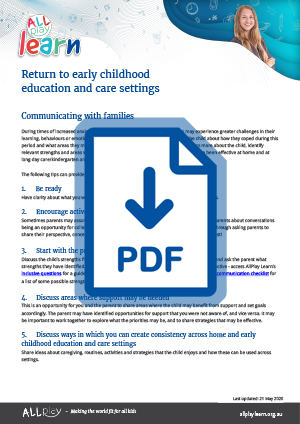
Educator Guide to
Parent-Educator Communication
Regular communication with parents provide an opportunity for you to share with a parent how their child is settling in at long day care or kindergarten and how they are progressing. You can learn more about the child, identify relevant strengths and areas where support may be needed, share strategies that have been effective at home and at long day care/kindergarten and work towards creating consistency across settings.
The following tips can provide a prompt and guidance when speaking with parents:
1. Be ready
Have clarity about what you want to say and specific areas or topics you would like to discuss.
2. Encourage active participation
Sometimes parents may assume more of a listening role when meeting with you. Reassure parents about conversations and meetings being an opportunity for collaboration. Encourage active participation and problem solving through asking parents to share their perspective, concerns and experiences. Remember, a parent knows their child best!
3. Start with the positive
Discuss the child’s strengths first. Share with the parent any strengths you feel are relevant, and ask the parent what strengths they have identified. Access AllPlay Learn’s strengths and abilities for a list of some possible child strengths. Consider completing this together with families.
4. Discuss areas where support may be needed
This is an opportunity for the parents and you to share areas where the child could benefit from support and set goals accordingly. The parent may have identified opportunities for support that you were not aware of, and vice versa. It may be important to work together to explore what the priorities may be, and to share strategies that may be effective. Strategies that draw on the child's strengths may be most effective - access AllPlay Learn’s inclusive questions for a guide to drawing on child strengths.
5. Discuss ways in which you can create consistency across home and early childhood education and care settings
Share ideas about caregiving, routines, activities and strategies that the child enjoys and how these can be used across settings.


